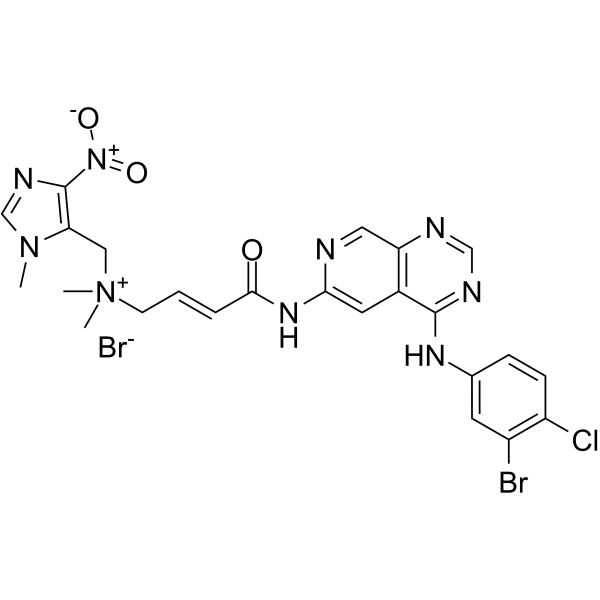
Tarloxotinib bromide
CAS No. 1636180-98-7
Tarloxotinib bromide( TH-4000 )
Catalog No. M26475 CAS No. 1636180-98-7
Tarloxotinib bromide is an irreversible inhibitor of EGFR/HER2.
Purity : >98% (HPLC)
 COA
COA
 Datasheet
Datasheet
 HNMR
HNMR
 HPLC
HPLC
 MSDS
MSDS
 Handing Instructions
Handing Instructions
| Size | Price / USD | Stock | Quantity |
| 5MG | 335 | Get Quote |


|
| 10MG | 500 | Get Quote |


|
| 25MG | 806 | Get Quote |


|
| 50MG | 1098 | Get Quote |


|
| 100MG | 1485 | Get Quote |


|
| 200MG | Get Quote | Get Quote |


|
| 500MG | Get Quote | Get Quote |


|
| 1G | Get Quote | Get Quote |


|
Biological Information
-
Product NameTarloxotinib bromide
-
NoteResearch use only, not for human use.
-
Brief DescriptionTarloxotinib bromide is an irreversible inhibitor of EGFR/HER2.
-
DescriptionTarloxotinib bromide is an irreversible inhibitor of EGFR/HER2.(In Vitro):Tarloxotinib bromide is metabolized efficiently under hypoxia using a panel of human NSCLC cell lines (rate of TKI release 0.4-2.1 nM/hr/106 cells), a process that is inhibited by oxygen (TKI release <0.002 nM/hr/106 cells). Cellular anti-proliferative and receptor phosphorylation assays demonstrate a 14-80 fold reduction of Tarloxotinib bromide activity relative to TKI. Using PC9 tumors, hyperbaric oxygen breathing suppresse release of TKI from Tarloxotinib bromide by >80% (538 vs 99 nM/kg; p<0.01) compared to air breathing controls.(In Vivo):Tarloxotinib bromide treatment regresses the WT EGFR NSCLC tumor models H125 and H1648, demonstrating Tarloxotinib bromide provides the necessary therapeutic index to inhibit WT EGFR in vivo.
-
In VitroTo confirm the mechanism of action, Tarloxotinib bromide is shown to be metabolized efficiently under hypoxia using a panel of human NSCLC cell lines (rate of TKI release 0.4-2.1 nM/hr/106 cells), a process that is inhibited by oxygen (TKI release <0.002 nM/hr/106 cells). Cellular anti-proliferative and receptor phosphorylation assays demonstrate a 14-80 fold reduction of Tarloxotinib bromide activity relative to TKI. Using PC9 tumors, hyperbaric oxygen breathing suppresse release of TKI from Tarloxotinib bromide by >80% (538 vs 99 nM/kg; p<0.01) compared to air breathing controls. Collectively, these data further validate that Tarloxotinib bromide is a hypoxia-activated irreversible EGFR-TKI, and show that Tarloxotinib bromide has greater activity compared with erlotinib.
-
In VivoA prototypic WT EGFR driven xenograft model (A431) is used to benchmark Tarloxotinib bromide activity against each EGFR-TKI by “retrotranslation” of reported plasma exposure for each agent in human subjects back to the xenograft model. Only treatment with clinically relevant doses and schedules of Tarloxotinib bromide is associated with tumor regression and durable inhibition of WT EGFR tumor phosphorylation. Consistent with these findings, Tarloxotinib bromide treatment can also regress the WT EGFR NSCLC tumor models H125 and H1648, demonstrating Tarloxotinib bromide provides the necessary therapeutic index to inhibit WT EGFR in vivo.
-
SynonymsTH-4000
-
PathwayAngiogenesis
-
TargetEGFR
-
Recptor——
-
Research Area——
-
Indication——
Chemical Information
-
CAS Number1636180-98-7
-
Formula Weight681.77
-
Molecular FormulaC24H24Br2ClN9O3
-
Purity>98% (HPLC)
-
SolubilityIn Vitro:?DMSO : ≥ 33 mg/mL (48.40 mM)
-
SMILES[Br-].Cn1cnc(c1C[N+](C)(C)C\C=C\C(=O)Nc1cc2c(Nc3ccc(Cl)c(Br)c3)ncnc2cn1)[N+]([O-])=O
-
Chemical Name——
Shipping & Storage Information
-
Storage(-20℃)
-
ShippingWith Ice Pack
-
Stability≥ 2 years
Reference
1.Frederick Glenn WEST, et al. Treatment of infectious disease.WO2019183729A1
molnova catalog



related products
-
CCF642
CCF642 is a novel PDI-inhibiting compound with antimyeloma activity.
-
A-935142
A-935142 is a human ether-a-go-go-related gene (hERG, Kv 11.1) channel activator that enhances hERG currents by slowing inactivation, promoting activation, reducing inactivation, and shortening atrial and ventricular repolarization in a complex manner.
-
Naquotinib mesylate
Naquotinib (ASP-8273) is a potent, irreversible, mutant-selective inhibitor of EGFR.



 Cart
Cart
 sales@molnova.com
sales@molnova.com


